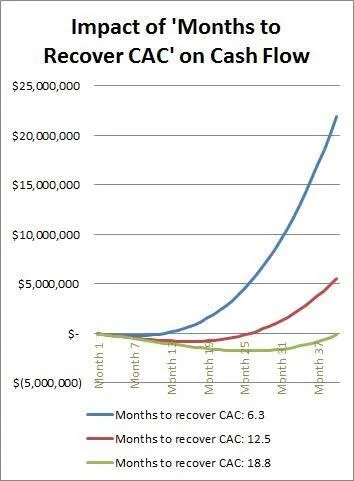Hey!
Me again. If you didn’t already realise, I’m passionate about fixing the unique problems and financial demands of the SaaS industry.
In my years as a SaaS founder, I’ve often grappled with metrics and KPIs to gauge the health and viability of a business. Today, in the first-of-many-articles, I want to talk about one of those important metrics, the Payback Period.
What is Payback Period in the context of SaaS?
To put it simply and without sounding patronising, the Payback Period in SaaS is the amount of time it takes for a company to recoup its investment in acquiring a new customer, or in other words, its Customer Acquisition Cost (CAC).
I’ll use round and totally generic numbers as an example here. If your company spends £1200 on marketing and sales to acquire a new customer, and that customer pays you £100 per month, your Payback Period is 12 months. You only start generating profit from this customer after a year. Pretty simple stuff.
Why does it matter?
In a volatile economy, especially in its current state, whilst cash is king, cash-FLOW is the sovereign..
The Payback Period is critical to SaaS companies because it directly impacts cash flow. The quicker a company recoups its CAC, the better its cash position, and the less it needs to rely on outside funding or credit products.
Moreover, in the early stages of a startup, the Payback Period can often be a more insightful metric than the Customer Acquisition Cost to Lifetime Value ratio (CAC/LTV). The latter can sometimes be deceptive, particularly when a company’s growth is driven by venture funding and the LTV is not fully realised yet.

What is considered a good Payback Period?
While this can vary depending on industry and business model, a Payback Period of 12 months or less is generally considered healthy for SaaS businesses.
A shorter Payback Period allows companies to reinvest more money into growth areas more quickly and reduces reliance on outside capital, because again, right now, that’s bloody hard to get.
How do you calculate it?
The Payback Period is calculated by dividing the CAC by the average monthly recurring revenue per user, also known as MRR.
To work out the CAC, divide the total spent on acquiring new customers (marketing and sales expenses) by the number of customers acquired in the given period.
For MRR, simply calculate the total monthly recurring revenue generated from your customers.
Let’s use an example. If you spent £10,000 to acquire 10 customers, your CAC is £1,000. If each of these customers subscribes to a plan that costs £100 per month, your MRR per customer is $100. Thus, your Payback Period is 10 months.
It’s worth noting that the Payback Period should be considered in light of the gross margin (revenue minus the cost of goods sold, divided by the revenue). A shorter Payback Period at a lower margin may not be as advantageous as a longer Payback Period at a higher margin.
PS - we’re assuming here that there is no customer churn….we’re going to save that for another day.
How can your pricing strategy affect your Payback Period?
Your pricing strategy is directly linked to your payback period. Higher prices may lead to a longer sales cycle but a shorter Payback Period, while lower prices might result in quicker sales but a longer Payback Period.
The decision between monthly and annual subscriptions also comes into play here. Annual subscriptions provide upfront cash, reducing your Payback Period. However, the higher upfront cost could be a barrier for some customers. On the other hand, monthly subscriptions might be more accessible, but extend your Payback Period.
So, what should you do next?
Start by understanding your current Payback Period and what factors are affecting it. Look at your pricing strategy - are there opportunities to optimise it to reduce the Payback Period?
Remember, the goal is not necessarily just to decrease the Payback Period, but to find a balance that suits your business model and cash flow needs.
Remember, in the current ‘Pay Later’ economy, finding innovative ways to meet customers’ financial needs can be a game-changer. Offering flexible payment options, like allowing customers to commit to an annual plan but spread the payment across the year, could be the answer to improving your Payback Period while still accommodating your customers’ needs.
In conclusion, understanding and optimising your Payback Period is crucial to your SaaS company’s survival and growth. It provides insight into your cash flow health, enabling you to make strategic decisions that move the needle forwards for your business.
Until next time.

